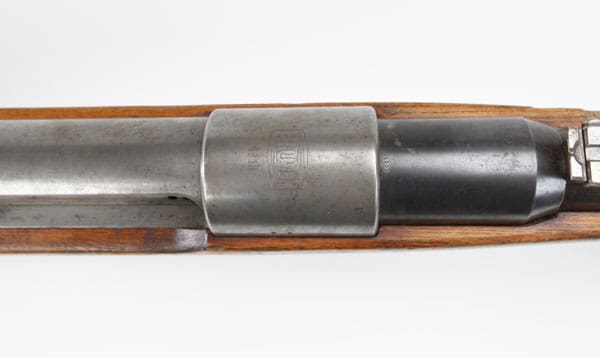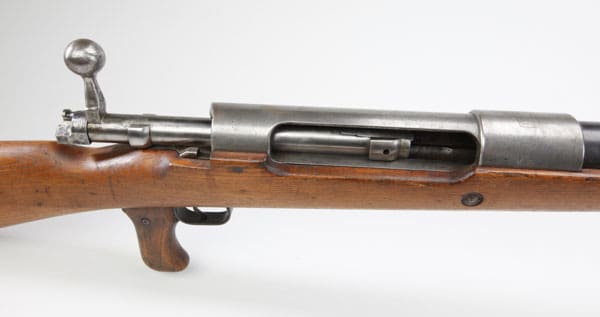
As we begin the commemoration of the centennial of the United States’ involvement in WWI, let’s take a minute and look at a “firearm first” from that era. The Mauser 1918 T-Gewehr rifle holds the distinction of being the first gun specifically designed to target tanks. Up until that point, tanks weren’t really a thing, so WWI arms makers had to come up with something original to combat this new threat.
By 1917, the German army had discovered – much to their dismay – that their 7.92x57mm armor-piercing rounds weren’t effective against British-built Mark IV tank armor. By today’s standards, the Mark IV armor, which ranged between one-quarter and one-half-inch thick, is paltry at best. Nonetheless, it was a formidable obstacle in 1917.

To fix this problem, the Germans approached renowned gunsmiths at the Mauser factory to create something that would strike fear in the hearts of British tank crews. By 1918, the T-Gewehr was in production. It fired a 13mm round that was sure to penetrate the tank’s armor. From that point on, the Mark IV tanks were no longer safe.

In addition to being the world’s first anti-tank rifle, the T-Gewehr was also the only anti-tank rifle to see service in WWI. While this gun is forgotten by most people today, it played a significant role in how war would be fought throughout the 20th century and into the 21st.
(Firearm courtesy of NRA Museums)
Logan Metesh is a firearms historian and consultant who runs High Caliber History LLC. Click here for a free 3-page download with tips about caring for your antique and collectible firearms.




C&Rsenal and Forgotten Weapons did much better with this subject quite some time ago.
‘…the Germans approached renowned gunsmiths at the Mauser factory to create something that would strike fear in the hearts of British tank crews.’
From what I’ve heard the British tank crews were too drowsy from the carbon monoxide and 120 degree temperatures to be stricken with fear from enemy fire.
I suspect that you know, but others may not…. Our World War (on Netflix) did a nice job of portraying the conditions in those tanks.
If I remember right, they lost more men to CO poisoning and heat stroke than enemy fire. The engines just sat in the middle of the tank.
” The engines just sat in the middle of the tank.”
Wasn’t the US’s Sherman tank in WWII powered by an aircraft radial engine pancaked flat in the middle of that tank?
How hot did it get in there?
(Rhetorical question, as hot as it just may get in Syria since Trump just attacked the airfield where the poison gas attack was launched with a few dozen cruise missiles, the very same airfield currently occupied by RUSSIAN FUCKING MILITARY FORCES? You know, the ones who take their orders from VLADIMIR FUCKING PUTIN? Sleep easy, TTAG friends, this just make get *interesting*…)
EDIT – It appears we know the Russians were aware the Syrians were loading that poison gas in real-time when that attack was launched. Interesting…
This could be one hell of a message Trump is sending to China’s president, who is visiting Trump right now in Florida.
The message to China being -Trump is serious he *will* deal with Fat-Boy Kim Jong Un if he has to.
I wonder if president Xi is getting much sleep tonight?
Geoff. The radial engine that was the first power palant in the Sherman was mounted, I believe, upright. Part of the reasons for the tank being tall and narrow.
The ww1 tanks had the engine in the same compartment as the crew, By ww2 the tanks normally had engines and crews in seperate compartments.
In my day armored vehicles tended to be hot, noisey and uncomfortable. I can’t imagine it would have been better in ww2.
I can’t speak for ww1. But the stats in ww2 show that you were much more likely, if you were a tank crew, to be killed by anti tank weapons than by other tanks.
When ww2 started a lot of countries were still using anti tank rifles in the 13-20mm bore range.
That makes sense because it took all sides a little while to realize that they could use tanks to kill other tanks. Pre-war doctrine had them all using anti-tank artillery pieces and anti tank rifles to destroy enemy tanks.
I wonder if those numbers include kills by tank destroyers as well.
Anti tank guns are simply smaller and easier to hide than a tank. Make the tanks take the offensive and you have a recipe for dead tanks. Combine with improving hand held A-T weapons such as the panzerfausts and bazooka’s and you have a situation that makes tank killing so much more certain.
I saw a video of some people firing one of these at a range in Tasmania (obviously pre- Port Arthur massacre).
It did not look pleasant to shoot. Even when prone the firers were visibly pushed back by the recoil. NO-ONE had a another turn.
C&Rsenal girl Mae fires it and then discusses the recoil with Othias. https://www.youtube.com/watch?v=_mWeNNiG9YU
That’s a neat video!
In it, he mentions the round was rimmed ‘for strength’, I thought rimmed rounds were primarily for eliminating errors in headspacing???
In all fairness about the recoil, in the video they mention the rounds they fired were lighter brass and copper reload slugs, as original rounds were too expensive for them to shoot.
They modified one of those lighter rounds (they called it a ‘bubba’ round) by installing a 1/8 tool steel rod as a penetrator in it, and the video showed it did markedly better than the ‘tame’ lightweight reload slugs.
They claimed the powder charge was to original factory spec on the reloads…
Hmm. I believe one could come to at least appreciate recoil from shooting these … especially given an alternative of becoming tank tread lube.
This weapon was the grandpa of the .50 BMG. American armorers studied the design and improved upon it. The rest is history.
Pistol grip. PISTOL GRIP.
Oh, the humanity!
That there’s whatcha call an ‘asphalt weapon’!
Now that’s a rifle.
Comments are closed.